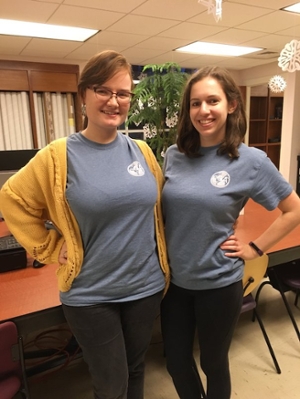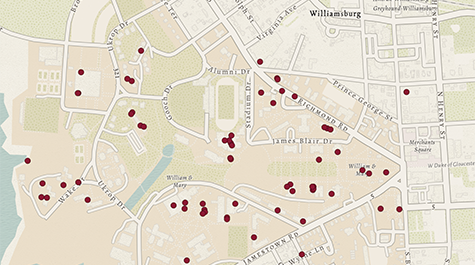Mapping campus love stories
The following story originally appeared in as an online exclusive for the W&M Alumni Magazine. - Ed.
As students, Kira Holmes ’17 and Colleen Truskey ’17 heard a rumor that 25% of William & Mary students end up marrying someone else from the university. Later, as post-baccalaureate fellows at William & Mary’s Center for Geospatial Analysis (CGA), they wondered: Where are all these people meeting each other and falling in love? Can we crowdsource data to learn more about this? And could this project help W&M students learn more about geospatial analysis?
The result was the “Where W&M Couples Meet” map, where students and alumni can plot where, when and how they met their significant other. (You can add your love story to the map using this online form.) The map launched for Valentine’s Day 2018.
“Based on the map right now, you are most likely to marry your freshman biology lab partner,” laughs Holmes, who is also part of an alumni couple. “Unfortunately, most of those matches happened in Millington Hall, which doesn’t exist anymore.”
 “In that sense, the map is a time capsule,” adds Truskey. “It allowed us to collect stories, and it was a fun way to get people involved in mapping. It encouraged people to think about their relationship to space differently and the way people over time interact in the same places.”
“In that sense, the map is a time capsule,” adds Truskey. “It allowed us to collect stories, and it was a fun way to get people involved in mapping. It encouraged people to think about their relationship to space differently and the way people over time interact in the same places.”
This project was one of the ways Holmes and Truskey engaged students with the work of the CGA during their fellowships. The CGA is a resource for W&M faculty, staff and students, as well as the broader community, for all things related to mapping and the visualization of spatial data using geographic information systems (GIS). Each year, they bring on two or three fellows.
“The fellows bring such creative ideas,” says Shannon White, interim director and coordinator of CGA’s certificate program. “Each group of fellows builds on the projects of the previous cohort.”
As well as promoting the CGA on campus through outreach events and fun maps like this one, fellows help teach other students about GIS and assist faculty and community partners in creating useful data-driven maps. For example, Truskey helped faculty develop maps to be published in journal articles and created a map to visualize the worldwide scope of the 2018 “Race, Memory, and the Digital Humanities” conference. Holmes helped map local insect species and analyzed topography along the James River. They also worked on a project with FeedVA to map food insecurity in Virginia, a project that is still maintained by current fellows.
“Our work as fellows helped students understand that GIS is a really useful skill for any kind of research, not to mention it looks great on your resume,” says Holmes. “It’s important to notice what’s happening around you and develop spatial awareness. Where you are matters — for example, if you’re in a food desert or a floodplain, that affects your life.”
Holmes also helped teach GIS skills in a class led by professors Rob Rose and Rebecca Green, who were 2018 W. Taylor Reveley, III Interdisciplinary Faculty Fellows. The class used GIS to draw different options for Virginia’s electoral map to learn more about the consequences of gerrymandering. The class is still offered each year.
Through these projects and connections with CGA alumni, fellows and students gain insight into how various industries use GIS and access to career opportunities.
As a geology major, Holmes was interested in computer modeling and mapping, which led her to apply for the CGA fellowship after graduation. She now works for a health care IT firm and volunteers for the Madison Audubon Society in Wisconsin, doing GIS work.
Truskey, an anthropology major, took a GIS class in her senior year, because she was interested in learning how to use maps to better understand and communicate social conditions. She applied for the fellowship because she wanted more practice with these skills. Now, she is an interdisciplinary GIS specialist with the National Park Service.
“Colleen and I really complemented each other. She’s more on the people side and I’m more on the science side. I was interested in computer programming and automating the processes, and Colleen was better at making it look good and communicate well,” says Holmes.
Those kinds of pairings are intentional in the CGA, says White. Each set of fellows helps hire the next set, and fellows don’t need to come into the program with a high level of skill in GIS — the fellowship is designed to help them learn more about it. With additional private funding, the CGA hopes to be able to expand the number of fellows and increase opportunities to engage with students.
“Through CGA, we are making connections between alumni and students, and students and the professional world,” says White. “We want our alumni to stay connected with what they are passionate about at William & Mary.”
Truskey and Holmes are proud to see the work they furthered at CGA living on through the next set of fellows.
“CGA was my home and got me through some tough times,” says Holmes. “We wanted to make the CGA a welcoming place to hang out and conduct research and make maps, and I hope that’s part of our legacy.”















